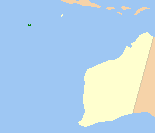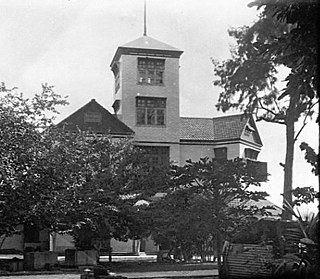
The Cocos (Keeling) Islands, officially the Territory of Cocos (Keeling) Islands, are an Australian external territory in the Indian Ocean, comprising a small archipelago approximately midway between Australia and Sri Lanka and relatively close to the Indonesian island of Sumatra. The territory's dual name reflects that the islands have historically been known as either the Cocos Islands or the Keeling Islands.

Wayang, also known as wajang, is a traditional form of puppet theatre play originating from the Indonesian island of Java. Wayang refers to the entire dramatic show. Sometimes the leather puppet itself is referred to as wayang. Performances of wayang puppet theatre are accompanied by a gamelan orchestra in Java, and by gender wayang in Bali. The dramatic stories depict mythologies, such as episodes from the Hindu epics the Ramayana and the Mahabharata, as well as local adaptations of cultural legends. Traditionally, a wayang is played out in a ritualized midnight-to-dawn show by a dalang, an artist and spiritual leader; people watch the show from both sides of the screen.

The Clunies-Ross family were the original settlers of the Cocos (Keeling) Islands, a small archipelago in the Indian Ocean. From 1827 to 1978, the family ruled the previously uninhabited islands as a private fiefdom, initially as terra nullius and then later under British (1857–1955) and Australian (1955–1978) sovereignty. The head of the family was usually recognised as the resident magistrate, and was sometimes styled as the "King of the Cocos Islands"; a title given by the press.

The Australian Indian Ocean Territories is the name since 1995 of an administrative unit under the Australian Department of Infrastructure, Transport, Regional Development, Communications and the Arts, consisting of two island groups in the Indian Ocean under Australian sovereignty:

The Shire of Cocos (Keeling) Islands is a local government area which manages local affairs on the Australian external territory of Cocos (Keeling) Islands. The island is grouped with Western Australia but is administered by the Department of Infrastructure, Regional Development and Cities and an Administrator.

Cocos Malays are a community that form the predominant group of the Cocos (Keeling) Islands, which is now a part of Australia. Today, most of the Cocos Malay can be found in the eastern coast of Sabah, Malaysia, because of diaspora originating from the 1950s during the British colonial period.

West Island, part of the South Keeling Islands, is the capital of the Cocos (Keeling) Islands, an Australian external territory in the Indian Ocean. The population is roughly 120 making it the third smallest capital in the world, and consists mainly of Europeans. It is less populous than Home Island, the only other inhabited island.

North Keeling is a small, uninhabited coral atoll, approximately 1.2 square kilometres (0.46 sq mi) in area, about 25 kilometres (16 mi) north of Horsburgh Island. It is the northernmost atoll and island of the Australian territory of the Cocos (Keeling) Islands. It consists of just one C-shaped island, a nearly closed atoll ring with a small opening into the lagoon, about 50 metres (160 ft) wide, on the east side. The lagoon is about 0.5 square kilometres (0.19 sq mi) in area. The island is home to the only surviving population of the endemic, and endangered, Cocos buff-banded rail, as well as large breeding colonies of seabirds. Since 1995, North Keeling Island and the surrounding sea to 1.5 kilometres (0.93 mi) from shore have been within the Pulu Keeling National Park.

Horsburgh Island is one of the Cocos (Keeling) Islands. Its area is 1.04 square kilometres. There is a small lagoon in the interior of the island to the northeast.

Home Island, also known locally as Pulu Selma, is one of only two permanently inhabited islands of the 26 islands of the Southern Atoll of the Cocos (Keeling) Islands, an Australian external territory in the central-eastern Indian Ocean.

Kedahan Malays or commonly known as Orang Utara ('Northerners'), is a sub-group of Malays who are native to northern Malaysia and in southernmost parts of Thailand and Burma. They are among the earliest settlers in the Malay peninsula. Kedahan Malays comprised at least 15% of the total Malaysian Malay population and constitute over 75% of the Kedah state population, thus making them the largest ethnic group in the state of Kedah.

Although it is an Australian External Territory, the culture of the Cocos (Keeling) Islands has extensive influences from Malaysia and Indonesia.

Wayang kulit is a traditional form of puppet-shadow play originally found in the cultures of Java and Bali in Indonesia. In a wayang kulit performance, the puppet figures are rear-projected on a taut linen screen with a coconut-oil light. The dalang manipulates carved leather figures between the lamp and the screen to bring the shadows to life. The narratives of wayang kulit often have to do with the major theme of good vs. evil.

Indonesian numismatic charms, also known as Indonesian magic coins, are a family of coin-like objects based on a similar Chinese family of coin charms, amulets, and talismans but evolved independently from them. Indonesian numismatic charms tend to have been influenced a lot by Hinduism, Islam, and the native culture and often depict religious imagery from Hinduism for this reason. The "magic coins" and temple coins from Indonesia are largely based on the Chinese cash coins introduced to the region during the Tang dynasty era in China, and during the local Majapahit era they began circulating in the region. Unlike with Chinese numismatic charms, the coin charms of Indonesia have not been as well documented both historically and in the modern era. A major modern day work about Indonesian numismatic charms in English is Joe Cribb's Magic coins of Java, Bali, and the Malay Peninsula which is a catalogue based on the collection of coin-shaped charms from the island Java acquired by Sir Thomas Stamford Raffles during his lifetime held in the British Museum, the book is further supplemented with data and information available from various other sources.
The West Island Mosque is a heritage-listed mosque at Alexander Street, West Island, of the Cocos (Keeling) Islands, an external territory of Australia. The mosque was added to the Australian Commonwealth Heritage List on 22 June 2004.
The Home Island Industrial Precinct is a heritage-listed industrial area at Jalan Bunga Mawar, Home Island, Cocos (Keeling) Islands, Australia. It was added to the Australian Commonwealth Heritage List on 22 June 2004.
The Direction Island Slipway and Tank are heritage-listed industrial remnants at Direction Island, Cocos (Keeling) Islands, Australia. The site was added to the Australian Commonwealth Heritage List on 22 June 2004.

Oceania House is a heritage-listed house at Jalan Bunga Kangkong, Home Island, Cocos (Keeling) Islands, Australia. It was added to the Australian Commonwealth Heritage List on 22 June 2004.

The Home Island Cemetery is a heritage-listed cemetery at Home Island, Cocos (Keeling) Islands, Australia. It was added to the Australian Commonwealth Heritage List on 22 June 2004.
The Old Co-op Shop is a heritage-listed retail building at Jalan Bunga Mawar, Home Island, Cocos (Keeling) Islands, Australia. It was added to the Australian Commonwealth Heritage List on 22 June 2004.
















